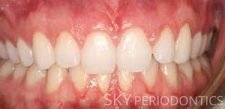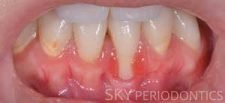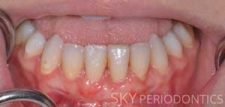Gum and Bone Repair
Crown Lengthening Procedure
You may have asked your periodontist about procedures to improve a "gummy" smile because your teeth appear short. Your teeth may actually be the proper lengths, but they're covered with too much gum tissue. To correct this, we perform a dental crown lengthening procedure.
During the procedure, excess gum and bone tissue is reshaped to expose more of the natural tooth. This can be done to one tooth, to even your gum line, or to several teeth to expose a natural, broad smile.
We may also recommend dental crown lengthening to make a restorative or cosmetic dental procedure possible. Perhaps your tooth is decayed, broken below the gum line, or has insufficient tooth structure for a restoration, such as a crown or bridge. Crown lengthening adjusts the gum and bone level to expose more of the tooth so it can be restored.
Gum Graft Surgery
Exposed tooth roots are the result of gum recession. Gum graft surgery will repair the defect and help to prevent additional recession and bone loss.
Gum grafts can be used to cover roots or develop gum tissue where absent due to excessive gingival recession. During gum graft surgery, we take gum tissue from your palate or another donor source to cover the exposed root. This can be done for one tooth or several teeth to even your gum line and reduce sensitivity.
A gum graft can reduce further recession and bone loss. In some cases, it can cover exposed roots to protect them from decay. This may reduce tooth sensitivity and improve the esthetics of your smile, allowing you to smile, eat and speak with comfort and confidence.
Pinhole Gum Rejuvenation®
This procedure, also known as Pinhole® Surgical Technique, is a scapel-free, minimally invasive procedure for correcting gum recession and saving teeth. Through a small hole made by a needle, specially designed instruments are used to gently loosen the gum tissue and glide it over the receded part of the tooth.
Pinhole Gum Rejuvenation involves no cutting, no stitching, and no grafting. The typical post-operative symptoms, like swelling and discomfort, are minimized, and there are instant cosmetic improvements. Most patients are able to resume light normal activities in 24-48 hours.
Site Specific Antibiotic Treatment
Local applications of antibiotics can help save your natural teeth.
Periodontal disease starts when bacteria form a sticky film along the gum line. This film, known as plaque, irritates the gums if not effectively removed by brushing and flossing. Eventually, the disease process can destroy the tissue that holds the teeth in place, as well as the bone that supports the teeth -- leading to tooth loss. Unfortunately it doesn't go away by itself.
As the disease progresses, periodontal pockets develop. These are areas where the gum has separated from the tooth. Bacteria that form in this pocket are not easily removed and can cause infection. As part of your treatment program we may recommend site specific antibiotic treatment to help kill the bacteria and eliminate the infection.
What's involved in the procedure?
After cleaning the pocket, your dentist will insert the antibiotic where it slowly dissolves over a 3 to 4 week period. There are no stitches or dental surgery involved with this procedure. After the antibiotic treats the gum infection, you should expect a reduction in the depth of the pocket - and the area will be easier for you to keep healthy. There are no eating restrictions, and ninety percent of patients experience no discomfort during the procedure.
Some content provided by American Academy of Periodontology.

Crown Lengthening - Before

Crown Lengthening - After

Esthetic Crown Lengthening - Before

Esthetic Crown Lengthening - After

Gum Graft - Before

Gum Graft - After